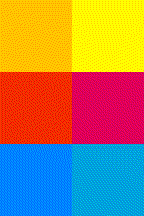| Dsc 121 | Fall 2000 | Rev 12 Sep 99 |
1.1.1 Exercise Example
 |
Description
Exercise 1.1.1 is a grouping exercise based on the psychological association we have for color and the physical world.
Terms
(1) simplex color; (2) hue; (3) relativity; (4) temperature; (see Glossary).
Task
Group the six simplex colors into two sets of three each based on color temperature.
Considerations
Which yellow seems redder, which greener?
Which red seems yellower, which bluer?
Which blue seems redder, which greener? |
Notes
Color temperature takes two meanings: (1) the physical meaning, and (2) the associative meaning. We work with associative temperature.
Associative Temperature Cool and warm are adjectives we apply to color, and we call the relative warmth or coolness of a hue temperature. Physical coolness and warmth are haptic sensations of touch, not vision but we describe colors this way because of the learned association to physical temperature sensations. We associate blood, fire, and sunlight colors as warm colors, and plant, sky, and water colors as cool colors.
Temperature Groups Color temperature is a color organization criteria (cool-warm contrast). We can classify colors as 'warm' colors or 'cool' colors. Like the cardinal compass points, red/green are spectrum and temperature opposites, and blue/yellow are spectrum and temperature opposites. We associate yellow-orange through red-violet as warm, and yellow-green through blue-violet as cool. Yellow and violet shift easily between the cool and warm groups.
Temperature Relativity Color temperature is relative. The same color can be warmer or cooler depending on its context (simultaneous contrast, successive contrast). Colors in the same group can be comparatively cooler or warmer. Reds, warm colors, can be cooler (closer to violet) or warmer (closer to orange). We describe one blue, a cool color, as warmer than another blue because it contains some red.
Physical Temperature Colors do not radiate heat. However, colored materials do absorb heat from radiant energy. Benjamin Franklin probably was the first person to show the degree that light and dark colored materials physically absorb heat from light. However, the terms, 'warm' and 'cool', are two of the psychological, perceptual-feeling reactions in people. Red wave lengths are longer than blue or violet wave lengths, but even this would not seem as important a factor as some early association of color with other sensory experiences.
Temperature in color science refers to the temperature in degrees Kelvin (K) of a black body as it heats up and changes color, or a black body changes temperature depending on the illuminating light color.
Environment Using cool colors cannot physically cool high-temperature environments, but they can lower the apparent environment temperature. Also, warmer colors may 'warm' low-temperature environments.
| Design Fundamentals return | Home return |
Prof Thomas Detrie | detrie@asu.edu
